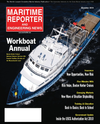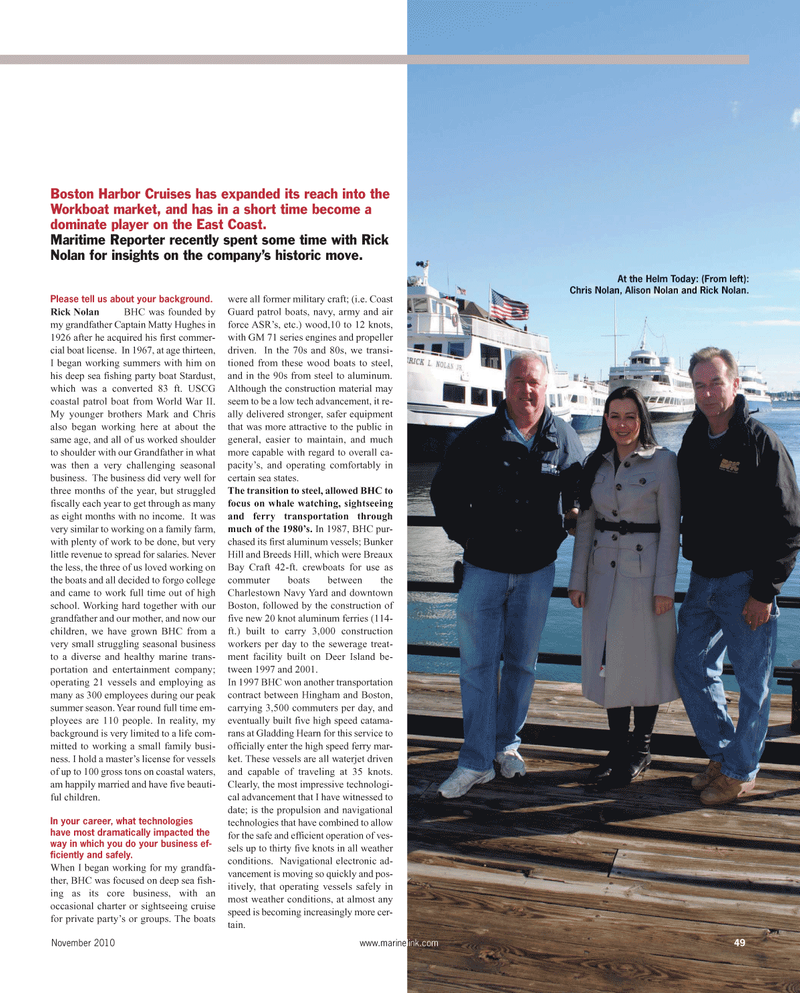
Page 49: of Maritime Reporter Magazine (November 2010)
Workboat Annual
Read this page in Pdf, Flash or Html5 edition of November 2010 Maritime Reporter Magazine
November 2010 www.marinelink.com 49
Please tell us about your background.
Rick Nolan BHC was founded by my grandfather Captain Matty Hughes in 1926 after he acquired his first commer- cial boat license. In 1967, at age thirteen,
I began working summers with him on his deep sea fishing party boat Stardust, which was a converted 83 ft. USCG coastal patrol boat from World War II.
My younger brothers Mark and Chris also began working here at about the same age, and all of us worked shoulder to shoulder with our Grandfather in what was then a very challenging seasonal business. The business did very well for three months of the year, but struggled fiscally each year to get through as many as eight months with no income. It was very similar to working on a family farm, with plenty of work to be done, but very little revenue to spread for salaries. Never the less, the three of us loved working on the boats and all decided to forgo college and came to work full time out of high school. Working hard together with our grandfather and our mother, and now our children, we have grown BHC from a very small struggling seasonal business to a diverse and healthy marine trans- portation and entertainment company; operating 21 vessels and employing as many as 300 employees during our peak summer season. Year round full time em- ployees are 110 people. In reality, my background is very limited to a life com- mitted to working a small family busi- ness. I hold a master’s license for vessels of up to 100 gross tons on coastal waters, am happily married and have five beauti- ful children.
In your career, what technologies have most dramatically impacted the way in which you do your business ef- ficiently and safely.
When I began working for my grandfa- ther, BHC was focused on deep sea fish- ing as its core business, with an occasional charter or sightseeing cruise for private party’s or groups. The boats were all former military craft; (i.e. Coast
Guard patrol boats, navy, army and air force ASR’s, etc.) wood,10 to 12 knots, with GM 71 series engines and propeller driven. In the 70s and 80s, we transi- tioned from these wood boats to steel, and in the 90s from steel to aluminum.
Although the construction material may seem to be a low tech advancement, it re- ally delivered stronger, safer equipment that was more attractive to the public in general, easier to maintain, and much more capable with regard to overall ca- pacity’s, and operating comfortably in certain sea states.
The transition to steel, allowed BHC to focus on whale watching, sightseeing and ferry transportation through much of the 1980’s. In 1987, BHC pur- chased its first aluminum vessels; Bunker
Hill and Breeds Hill, which were Breaux
Bay Craft 42-ft. crewboats for use as commuter boats between the
Charlestown Navy Yard and downtown
Boston, followed by the construction of five new 20 knot aluminum ferries (114- ft.) built to carry 3,000 construction workers per day to the sewerage treat- ment facility built on Deer Island be- tween 1997 and 2001.
In 1997 BHC won another transportation contract between Hingham and Boston, carrying 3,500 commuters per day, and eventually built five high speed catama- rans at Gladding Hearn for this service to officially enter the high speed ferry mar- ket. These vessels are all waterjet driven and capable of traveling at 35 knots.
Clearly, the most impressive technologi- cal advancement that I have witnessed to date; is the propulsion and navigational technologies that have combined to allow for the safe and efficient operation of ves- sels up to thirty five knots in all weather conditions. Navigational electronic ad- vancement is moving so quickly and pos- itively, that operating vessels safely in most weather conditions, at almost any speed is becoming increasingly more cer- tain.
At the Helm Today: (From left):
Chris Nolan, Alison Nolan and Rick Nolan.
Boston Harbor Cruises has expanded its reach into the
Workboat market, and has in a short time become a dominate player on the East Coast.
Maritime Reporter recently spent some time with Rick
Nolan for insights on the company’s historic move.

 48
48

 50
50
